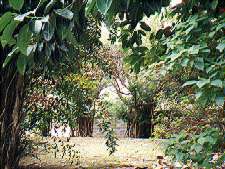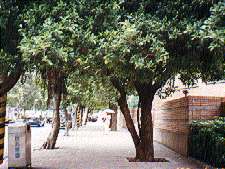
Taipei American School is a K-12 international school located in Tienmou, Taipei about 5 km from the foothills of Yangmingshan National Park. I have been in TAS since fifth grade, and began observing its wildlife since 1994.
Wildlife of Taipei American School

Taipei American
School is a K-12 international school located in Tienmou,
Taipei about 5 km from the foothills of Yangmingshan National Park. I have
been in TAS since fifth grade, and began observing its wildlife since 1994.
Address: 800, Chung-shan N. Rd, Shih Lin, Taipei, Taiwan, 111, Republic of China
![]()
THE WILDLIFE
|
|
Birds are the most representative of the wildlife at TAS. A total of 42 species have been recorded so far, and many more are bound to be discovered in the future. There are birds everywhere on the campus, and some species have become more accustomed to human disturbance than others. Tree Sparrows often hop about in the snack bar area scavenging for leftover crumbs, Little Egrets often visit the pond to feed on fish, and Red Turtle Doves gather in large flocks to feed on the lawn. Most of the species occurring on campus are common urban birds, but a number of rare species that may seem out out of place have also been discovered, including a large percentage of interesting escapees, such as parrots and even a toucan! |
|
|
Insects are the most abundant animals in TAS. They are found in all habitats, inside the building and out. Grasshoppers, locusts, katydids, crickets, and praying mantids are common in the grassy areas; dragonflies, damselflies, and water striders are found by the pond; cicadas make their appearance in the summer, singing loudly in the trees; butterflies and bees visit flowers in search of nectar; moths flutter around the flood lamps in the field; hornets and wasps annoy people in the field and build their nests outside classroom windows... just to name a few of the insects present on the campus. |
|
|
Obviously, fish are only found in Blanks' Pond. Since this pond was created in the middle of nowhere, all of the fish in it were introduced. The African cichlid, the tilapia, is the most plentiful. Other fish recorded in Blanks' Pond include the goldfish, koi carp, mosquito fish, Plecostomus catfish, mud loach (the species native to Taiwan), and a few other tropical African cichlids. |
|
|
 While
snakes have previously been recorded, the only four confirmed reptile species
in TAS so far are the red-eared turtles (Trachemys scripta elegans) and Chinese stripe-necked/green-headed turtles (Ocadia sinensis) introduced to Blanks'
Pond, an unidentified species of gecko, and the native dragon-lizard,
Japalura
swinhonis, a species endemic to Taiwan. While
snakes have previously been recorded, the only four confirmed reptile species
in TAS so far are the red-eared turtles (Trachemys scripta elegans) and Chinese stripe-necked/green-headed turtles (Ocadia sinensis) introduced to Blanks'
Pond, an unidentified species of gecko, and the native dragon-lizard,
Japalura
swinhonis, a species endemic to Taiwan. |
|
|
There are many species of frogs and one species of toad living in the gutters and Blanks' Pond, but more information has yet to be obtained about them. So far only the Indian rice frog/rice field frog (Rana limnocharis) and the spectacled toad (Bufo melanostictus) have been seen and identified. The Guenther's Amoy/brown frog (Rana guentheri) has been identified by its distinct barks. |
|
|
Only one crayfish (exotic species) has been captured from Blanks' Pond, even though shrimps are suspected to thrive as well. |
|
|
Mammals are the least understood of the animals of TAS. Mice are sometimes seen in and around the building, there is evidence of shrews digging under the soccer field, and bats fly around the flood lights at night catching insects. |
HABITATS
 |
Blanks' Pond
A small pond between the track and the softball field set aside in 1989 to provide students with an outdoor classroom where they can observe living creatures in an undisturbed ecosystem. The dominant fish in the pond is the tilapia, an edible cichlid introduced from Africa. Other inhabitants of the pond include goldfish, red-eared turtles, frogs, toads, water striders, shrimps, crayfish, and pond snails. Many species of birds visit the pond, such as the rare Chinese Pond Heron. Insects are also abundant in the tall grass, while butterflies are attracted to the flowers. Scaly-breasted Munias are suspected to breed in the palms on the side of the pond. |
 |
GAA Garden
This garden is maintained by the GAA club of Upper School. The Latanna flowers attract a huge variety of butterflies. The tall fir trees are nesting sites for Scaly-breasted Munias. |
 |
Fringe Habitat
This refers to the groves of trees planted along the side of the fields and along the walls. This habitat creates shade found nowhere else on campus, and is home to birds, cicadas, and dragon-lizards. The tall grass between separate groves of trees are home to warblers and prinias. |
 |
Softball Field & Track/Soccar Field
Both of these fields consist of a large, flat lawn often disturbed by athletic students. Dragonflies frequently congregate in great numbers before a shower, and grasshoppers, katydids, and flower beetles live in the grass. Doves, magpies, and thrushes often feed here when there are fewer people outside. The lighting system provides ideal perches for Black Drongos, mynas, and bulbuls. The escapee parrots were all seen in this area, usually in flight. |
 |
School Gates, Parking Lots, and Sidewalk
There are trees planted by the front gates of the school and in the parking lot where sparrows, bulbuls, and white-eyes frequent. The trees on the sidewalk outside the school gates provide nesting sites for these birds and also bear fruit at certain seasons which attract mynas and treepies as well. Large numbers of Red Turtle Doves and other birds often sit on the high telephone wires. Rarities such as the Oriental Skylark and escapee toucan were sighted in this area. |
 |
Rooftops
The flat, concrete rooftops of TAS may not be very attractive, but they are where ground-feeding birds take refuge from noisy kids during the day. Common birds include White/Pied Wagtails, doves, magpies, and occasionally the Blue Rock Thrush or Formosan Whistling Thrush. Raptors are rare, but are sometimes seen soaring above the rooftops. |